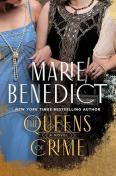
by Marie Benedict
Hardcover- $29.00
From the New York Times bestselling author of The Mystery of Mrs. Christie—a thrilling story of the five greatest women writers of the ...
Overall rating:
How would you rate this book?
Member ratings
What a fun book! I grew up reading the Golden Age mysteries, mainly Agatha Christie, borrowed from my grandma's house. When I got older I found even more authors waiting for me, like Margery Allingham and Ngaio Marsh. But what a treat to see them all working together to solve a crime. I would definitely recommend this one to fans of any of the author or classic mystery, and I'd love to read a sequel. The audio version was really good.
Thanks to the publisher and author for a chance to listen to this one.
The Queens of Crime: A Novel, Marie Benedict, author; Bessie Carter, narrator
The time is 1930, the place is London England, the event is the inaugural meeting of The Detection Club, a select group of well-known and accomplished authors of detective novels. Only two women were expected to be in the group, but with a bit of unorthodox, secret manipulation, Dorothy Sayers managed to include five.
The five women that call themselves Queens, -- Dorothy L. Sayers, Agatha Christie, Ngaio Marsh, Margery Allingham and Baroness Emma Orczy- form their own secret organization within the organization to attain well-deserved respect, additional power and well-earned recognition. Normally mocked by the men who feel far superior, they decide to solve an unsolved crime to prove themselves and elevate their position in the eyes of their chauvinistic, male counterparts.
Agatha Christie is well-known for her series on Hercule Poirot and Jane Marple. Margery Allingham is best known for her sleuth Albert Campion. Dorothy Sayers and the character Lord Peter Wimsey rocketed her to fame. Ngaio Marsh is famed for her Roderick Alleyn Mysteries, and Baroness Emma Orczy’s Scarlet Pimpernel speaks for himself. Of course, they are famous for far more, but suffice it to say, these women were and are worthy of inclusion in this most private, esteemed club of successful authors of detective novels.
The Queens settle on the idea of solving an unsolved murder case involving May Daniels, a young nurse who disappeared without a trace from the Gare Centrale washroom in Boulogne-Sur-Mer, France while on holiday with her friend Celia McCarthy. It leads them to the discovery of another odd disappearance, that of a woman named Leonora Denning, a violinist. Could these two disappearances be connected? Could there be more to the fate of these women than meets the eye? Is there a cover-up in the works? Are there very important and influential people being protected or are they protecting themselves? Unlike the men, the women reenact every scene that May Daniels may have experienced, and they explore every detail together, making suppositions and reaching conclusions that the men, in their haste to dismiss the crimes, as simply caused by the behavior of loose women or drugs, never even consider.
The women bend the law and exploit the rules in their attempt to elevate their reputations by solving the crime before the investigation officially closes. The story moves back and forth from London, England to the place where she disappeared in Boulogne, and the women find that sleuthing is far more dangerous than authoring novels. They do have great fun as well as facing great danger. In their endeavor, they prove that the insight of women is invaluable and that men often jump to conclusions whenever women are involved, often dismissing important clues and considerations when investigating crimes.
Quietly, the book explores the abortion issue and its devastating effects on women, especially in a world that is blind to their place in it, and therefore, it also explores the lack of equal rights that women must still to this day fight to overcome. Basing the story on some true crime issues and personal problems in the life of Sayers, they have put together a delightful read as the spirits of these women, through the eyes of the author, have basically collaborated to write this detective novel with their wits, their friendship, and their personal traumas. They have created the drama with their intellect. Unlike the men, they did not jump to the wrong conclusions simply because of a red herring, like a syringe conveniently placed at the scene of the crime. These women proved to these men that they were not, and never would be, “surplus women”!
There is a very real Detection Club. It was founded in 1930 by a group of 26 authors. Gilbert Chesterton was its first President.
Book Club HQ to over 90,000+ book clubs and ready to welcome yours.
Get free weekly updates on top club picks, book giveaways, author events and more








